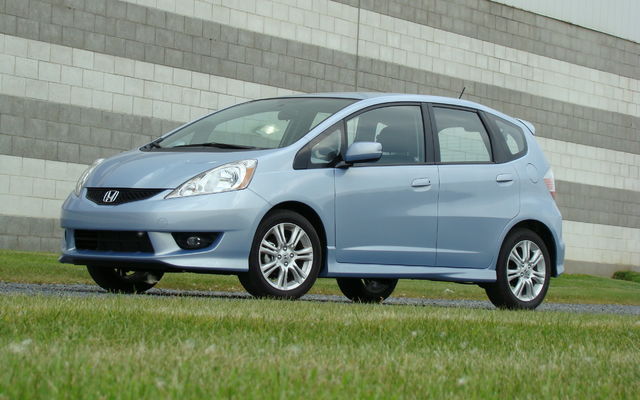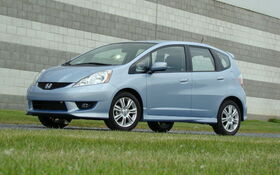The 2009 Honda Fit, My Car of the Year
When the Honda Fit first rolled onto the scene in 2007, it already had a fair bit of experience under its belt. Though introduced as a new model, it had already been sold in Europe for a few years under the name Jazz and in Japan as the Fit.
Well-received in Canada, the Fit’s silhouette betrayed its years. Its flat sides, for example, made it look narrow, while the interior was remarkably spacious, especially for a sub-compact.
This year, Honda has released a carefully refined and refreshed version of this little car. The new Fit is built on the same base architecture as its predecessor, but it’s been updated and improved – right up to the smallest details. And the result? Fantastic!
Still offered in the DX, LX and Sport versions, the Fit now also comes in the DX-A model, which is basically a DX with air con. Honda is expecting 45% of Fits sold to be LX models, 24% DX-A models, 22% Sports and 9% the basic DX.
Bigger, rounder, more spacious
The new Fit is much like the old one except that all its body panels are different. This plumper, more chubby-cheeked look suits it well. It’s also 106 mm longer, 13 mm wider and its wheelbase has been stretched by 50 mm. The front and back track widths are also up by 36 and 24 mm respectively.
All this adds up to more space, most notably in the back seats, which are now more easily accessible through doors that open up to 80 degrees. The engineers even found a way to improve the fabulous “magic seat.” You can now lift the seat cushion or lower the sections of the seat back with one hand for unparalleled versatility across all categories. Simple, solid, clever and practical, it’s truly Honda at its best.
According to the specs sheet, the new Fit actually offers a few millimetres less space up front than the old one, but you’d never guess it. It’s very spacious and offers great comfort. You certainly don’t have to wedge your right leg against the console like in other compacts.
The Fit’s gas tank is still hidden under the front seats, an ingenious idea that frees up more room in the cargo hold, making it exceptionally spacious for a vehicle of this size. Plus, this space is even more easily accessible thanks to the slightly lower threshold and floor.
The comfort and confidence of a bigger vehicle
The front seats are the same ones you’ll find in the Accord. The driver’s seat is well-sculpted and just firm enough. I loved the feel as soon as I got in and was comfortable during my entire six hours of driving. The seating position is not adjustable, and though it seemed a little low at first, I found the overall driving position excellent. They finally add a wide, flat and solid footrest, which I particularly appreciated. It corrects the most annoying flaw of the first Fit, which offered nothing more than an uneven little bump for your feet. Looking out of the vehicle, you get a great view of the front and sides. Visibility is obstructed at the three-quarter point toward the rear, despite the fact that the pillars are quite far back. But with great rear- and side-view mirrors, there’s really no problem.
The steering wheel is similar to that of the Civic, and it can be adjusted back and forth and up and down. It features impeccable cruise control buttons, and the levers on either side are well-made, precise and easily accessible. The air conditioning is controlled by three big vertically aligned knobs to the right of the steering wheel. Just next to those are the simple and cleanly designed sound controls. The dial plates are also inspired by the Civic, but these are a little too dark during the day. When night falls, however, the silver finish and blue lighting are pretty cool. Better still, all the controls are back-lit and well-identified, without exception. However, I don’t understand why there aren’t little lights on the ceiling up front. You have to make do with the light in the middle of the ceiling if you want to check your map once it’s dark out.
The cup holder on the left of the dash is narrow enough for a can of Red Bull or the something of the like. On the floor, the optional “all-season” rubber carpets are very effective and well integrated. The sides of these carpets seem to be high enough to hold in winter salt water and muck, which is, after all, their purpose.
Both solid and agile
I travelled 700 km to the Niagara Peninsula and back in a Sport equipped model with an automatic transmission. The Fit may be classed as a sub-compact, but it’s very decent on the road – not one of those light, fragile and bouncy little cars. The solid body seems bigger than that of the first Fit. And yet, this one is just 23 kg heavier, and most of this extra weight has gone to improving passive safety. The only points I could criticize the Fit for would be the noise you hear while driving (typical of Hondas) and a certain sensitivity to side winds. When passing 18-wheelers on the 401, the car consistently took a little sidestep. Offering a fairly firm drive, it’s less jumpy and nervous than the first Fit.
The Sport tends to follow all the ups and downs of the road, which can be somewhat unpleasant on bumpy roads or uneven surfaces. Plus, it’s sensitive to any holes in the road, and lets you know in a rather noisy way. The Sport comes with P185/55 R16 tires on alloy rims, whereas the DX and LX come with P175/65 R15 tires, which should result in a gentler ride.
The Sport’s steering is lively and linear, with spunky power-assistance, except at lower speeds, when the steering is a little lax. The brake modulation is impeccable under normal driving conditions. The Fit Sport was an absolute pleasure to drive on the circuit at the annual AJAC trials.. The anti-roll bar on the Sport models has a lot to do with making the Fit superbly agile, neutral in turns, and overall a lot of fun.
On this well-beaten track, which combines tight sections and rapid turn sequences, I even managed to catch up to a Jaguar XF Supercharged with the Fit Sport with automatic transmission. Its five speeds have a net advantage over the current competition’s four. They let you capitalize on the torque, which is delivered fairly quickly because the gear switch occurs smoothly and energetically. The manual version of the Fit is less convincing. Its stick shift is light but loose, and the distance between gears is too far. What’s more, the clutch is light and its bite is too dry. Driving that car smoothly takes concentration.
Just enough under the hood
The engine is a touched up version of the last one. The 1.5-litre four cylinders has gone from 109 hp at 5,800 rpm to 117 hp at 6,600 rpm, and the torque has gone from 105 to 106 lb-ft at 4,800 rpm. The accelerations are slightly zippier than on the previous model. The Fit Sport with the five speed automatic transmission can go from 0 to 100 km/h in 11.3 seconds (versus 12.27 seconds before) and the version with the six-speed manual transition can do it in 9.55 seconds (compared to 9.97 before).
So it’s obviously not a speed machine. The engine works up a sweat on inclines and makes more noise when you put the pedal to the metal than what we’re used to from Honda. Mixed fuel consumption, however, is down to 6.4 L/100km (compared to 6.8 before) despite the Fit’s size and weight gains. I calculated exactly 6.39 L/100 km on a Sunday drive in the countryside, but the car sucked up more than that on my trip to Niagara. It drank 7.59 L/100 km on that trip, which included 50 km of traffic and about 350 km at 118 km/h of highway driving.
Whatever the case, the Fit is remarkably comfortable, spacious and practical, with its terrific adjustable back seat. It’s at least as spunky, frugal and reliable as any other small car, while giving you the impression that you’re in a bigger vehicle. And frankly, I think she’s pretty!
Unless you have more than two kids and a boat you want to haul, you really don’t need more than what the Fit offers, especially in these uncertain times. That’s why the Honda Fit is my Car of the Year. Its unique qualities put it a nose ahead of the Hyundai Genesis.
I’ll never understand why it didn’t make the final cut for the North American Car of the Year or for the AJAC awards. I’d buy a Fit tomorrow without the slightest hesitation.












